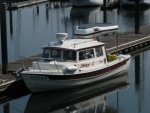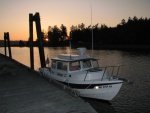BillE,
The wander tendency in idle is inherent in the design and there is no reasonable cost efficient way to overcome it.
The F150 exhausts out the prop hub, and even in neutral it’s a surprising amount of forward thrust. Around the docks, I’m in neutral more (time wise) than in forward or reverse gear.
To make a really tight turn from idle, (650 rpm) FIRST turn the wheel 2.5 turns (about 3 is max) in Neutral BEFORE pushing into Forward. A bit more than 650 rpm (say 7-800) will really swing it around, but seldom needed. In a narrow marina fairway, this combined with going back to neutral, turning the other way and then some Reverse at idle you almost can do a 360. Agree, practice all this in calm wind and water away from the marina with a float for reference.
Soon the mate will be adjusting fenders by throwing ‘bo-lins’ and clove hitches around the rails, in the dark with one hand, but until then “Fender-grip” cheaters make it very easy to make instant adjustments to fender hgt for different docks and can be tied to the roof rails to free up cleats for dock lines. Fenders come on sale for 40% off all the time. Like a case for your cell phone but even more waterproof.
Use pilings against the rub rail when needed to assist in tight turns or wind. The rub rail is made for this and won’t be hurt.
Choose marinas with “floating docks” when possible so you won’t have the bow get stuck under the dock at 2am with a very low tide (that has not happened to us since Friday, however).
https://www.amazon.com/s/?ie=UTF8&keywo ... th9i3k5f_e
You will get some scrapes and dings, many can be wet-sanded out with 400/800/1000 grit. Every 3-5 years pay a pro to fix them all to look good as new it they bother you.
Never, EVER yell at each other on the boat or off. Laugh a lot. We saw a boat named “Dammit, Jill!” Don’t be that boat.
The F150 has a lot of ‘prop rattle’ at idle. This was first described in ancient caveman pictographs and nothing much has changed since. You can get a Yamaha special SDS prop for a bit over a Boat Unit ($1,000) or just add 50-100 rpm and it will stop. It’s harmless.
Replace the trailer with an aluminum/SS with EOH SS or ceramic brakes, Goodyear Endurance (USA made) tires and you’ll be ready to trailer to the West Coast, even though you don’t plan on it now. We wasted $3,500 trying to upgrade the old trailer, but the new (2015) Wefings/Bob Austin Float-On is the best $9500 (yours would be cheaper) we’ve ever spent on boating. And only 1/3rd the cost of your idea!
Cheers!
John
Probably somewhere between the Tred Avon River and Kent Island Narrows on the Chesapeake, look for Cat O’ Mine AIS signal on Marinetraffic.com


